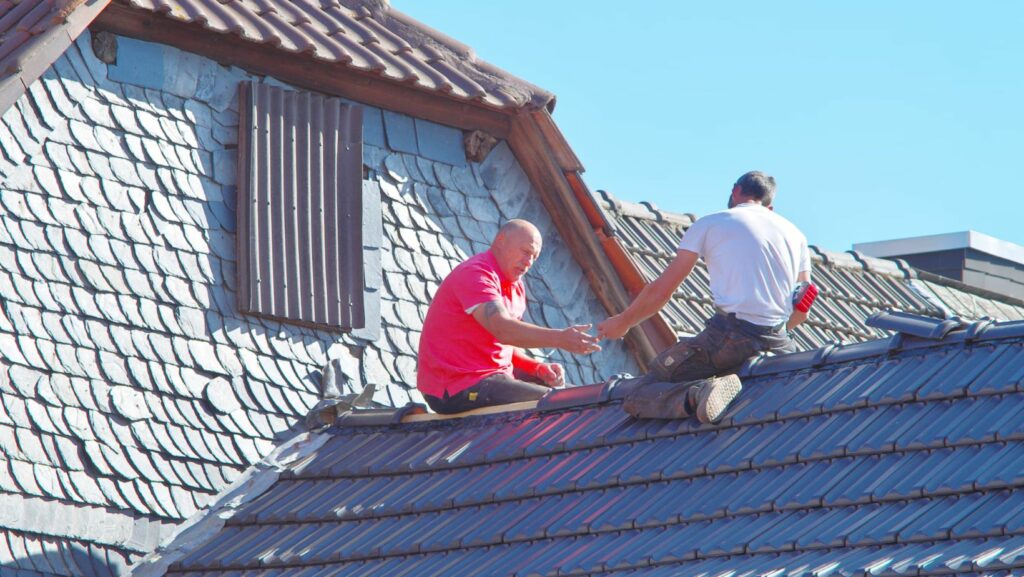Natural disasters can leave behind significant damage, and your roof often bears the brunt of these events. After a big storm, promptly assessing and addressing roof damage is crucial to prevent further complications.
How to Handle Post-Storm Roof Damage
Here’s a step-by-step guide on what to do if a storm damages your roof.
Ensure Safety First
Prioritize safety before anything else. Inspecting a storm-damaged roof can be dangerous, especially if the weather event has caused structural damage. Stay away from areas that appear compromised, and avoid climbing onto the roof until it has been deemed safe by professionals.
Conduct a Preliminary Inspection
From the ground, conduct a visual inspection to identify obvious signs of damage. Look for missing or damaged shingles, debris, and any other visible signs of impact. Using binoculars can help you get a closer look without putting yourself at risk. In some cases, it’s best to employ the help of professional roof inspectors as they can provide complete and accurate estimates.
Document the Damage
Take detailed notes and photographs of all visible damage. This documentation is vital for insurance claims.

Capture images from multiple angles. Don’t forget to include close-ups of specific damage points. This evidence will be essential when you contact your insurance company.
Contact Your Insurance Company
Report the roof damage to the insurance company as soon as possible. Provide them with your documentation and follow their instructions regarding the claims process. Many insurance companies will send an adjuster to assess the damage in person.
Hire a Professional Roofing Contractor
Engage a reputable roofing contractor to inspect and estimate repair costs. Ensure they are licensed and insured. Professional contractors can identify damage that might not be visible to the untrained eye and provide a detailed repair plan.
Beware of storm-chasing contractors who might appear immediately after a storm offering quick repairs. These contractors may not provide quality work and could disappear after being paid. Always verify credentials and check reviews or references before hiring anyone.
Make Temporary Repairs
If there are immediate risks of leaks, consider temporary repairs to prevent further damage. Use tarps or plywood to cover exposed areas until a professional can make permanent repairs. However, only attempt temporary fixes if it is safe to do so.
Understand Your Insurance Policy
Familiarize yourself with your insurance policy’s specifics, including coverage limits and deductibles.

Understanding what is covered can help manage expectations and financial planning for the repairs. In some cases, you might need to negotiate with your insurer to get the full benefits you’re entitled to.
Plan for Future Protection
Once repairs are completed, consider implementing measures to protect your roof from future storms. This might include installing impact-resistant shingles, reinforcing the roof structure, or adding storm shutters. Proactive steps can mitigate damage in future weather events. Getting an estimate for roofing will help you plan accordingly.
According to the Federal Emergency Management Agency (FEMA) report, storm frequency and severity will significantly increase, making these measures increasingly important.
Don’t Neglect Storm Damage
Addressing roof damage promptly after a storm is critical to maintaining the integrity of your home. By following these steps, you can ensure your roof is properly inspected, documented, and repaired, minimizing the risk of further damage.
- Prioritize safety and avoid inspecting a damaged roof yourself.
- Document all damage meticulously for insurance claims.
- Contact the insurance company and initiate the claim.
- Hire a licensed and insured professional roofing contractor for thorough inspection and repairs.
- Be wary of storm-chasing contractors and verify credentials before hiring.
- Understand your insurance policy to manage repair costs effectively.
- Plan preventive measures to protect your roof from future storms.
